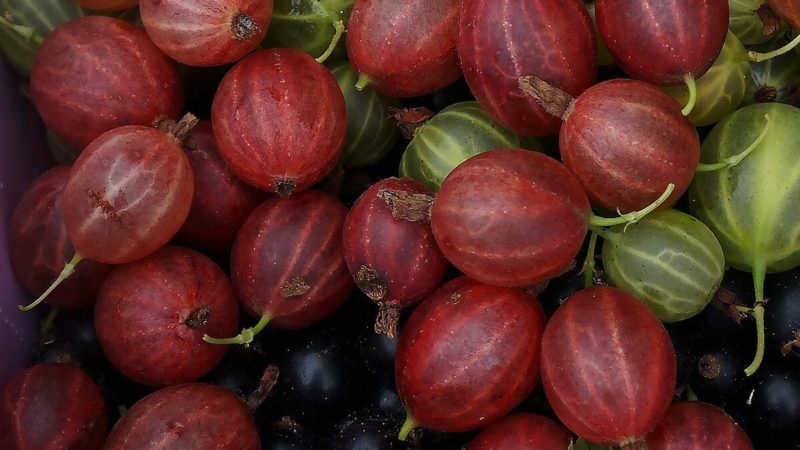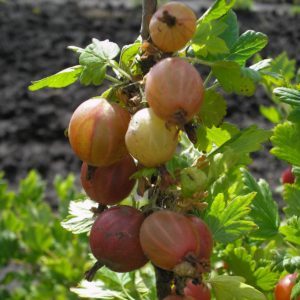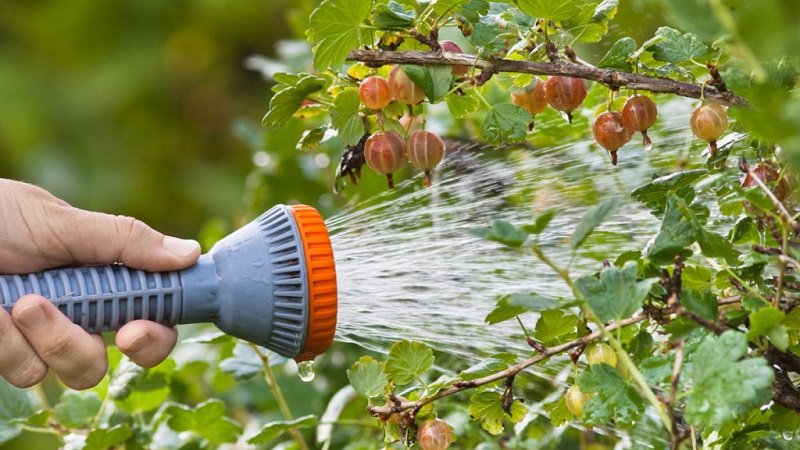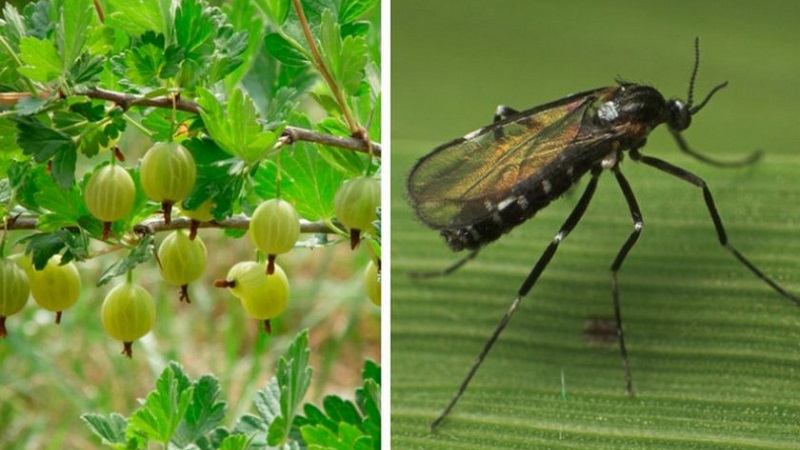Mid-late gooseberry variety Shershnevsky: pros and cons, cultivation features
Gooseberry Shershnevsky is the result of the work of domestic breeders. The variety fell in love with gardeners due to its unpretentious care, dessert taste of berries and a number of positive characteristics, including good immunity, drought and frost resistance. In this article we will talk about the advantages, disadvantages, requirements for planting and caring for Shershnevsky gooseberries.
The content of the article
What is this gooseberry variety
Shershnevsky belongs to the mid-late varieties of gooseberries. The harvest ripens in early August, but the berries can remain on the bushes without losing their taste until September.
Productivity - 3-3.5 kg per bush or 53.1 kg / ha. In order for the fruits to be stored longer and to tolerate transportation better, they are harvested 10-12 days before they are fully ripe. The berries are stored in the refrigerator for no more than 10 days.

History of origin and distribution
Gooseberry Shershnevsky was bred at the South Ural Research Institute of Fruit and Potato Growing by the breeder V. S. Ilyin as a result of pollination of the Lefort Seedling with a mixture of African pollen and Weak Spiked-2.
The variety was included in the State Register of Russia in 2006, and is recommended for cultivation in the Ural, Middle Volga, West and East Siberian regions.
Characteristics and description of the bushes
The plant is a vigorous, medium-spreading bush with straight green shoots, the tops of which are painted purple. On the shoots, in addition to their upper part, there are sharp, medium thick, long, single or double thorns of light beige or brown color.
Cuttings are green, slightly pubescent. The leaf plates are medium in size, 5-lobed, concave, not pubescent, soft and slightly wrinkled, shiny, dark green colored. There is a deep notch at the base; along the edges there are short, unbent teeth.
The buds are round in shape with a sharp top, small, light brown. Flowers of medium size, pale pink, collected in inflorescences of 2 pieces.
Resistant to temperatures
Bushes can withstand frosts down to -20 ° C without additional cover. However, in conditions of little snow, the root system may suffer.
Moisture and drought resistance
The variety tolerates drought and high air temperatures well; the berries do not bake in the sun. An excess of moisture and waterlogging of the soil provoke root rot.
Disease and pest resistance
Shershnevsky is characterized by high immunity, resistant to powdery mildew, but in rare cases it can be affected by anthracnose, rust, white spot, currant glassware, spider mites, aphids, moths, sawflies.
Characteristics and description of fruits
The berries are large or medium in size, rounded-oval, not pubescent, weigh an average of 3-5 g, covered with a dense dark pink skin with a matte bloom.
The fruits are characterized by a pleasant sweet and sour taste.
Application area
Shershnevsky's berries are consumed fresh, used to make preserves, jams or compotes.
Gooseberry fruits have a tonic, laxative, bile and diuretic effect.Due to their rich vitamin composition, they are used as an additive for cardiovascular diseases and in cosmetology.
Advantages and disadvantages of the variety
The main advantages of Shershnevsky:

- frost and drought resistance;
- yield;
- good immunity and resistance to powdery mildew;
- self-fertility;
- dessert taste;
- keeping quality and transportability.
Cons of the variety:
- the presence of thorns on the shoots;
- the tendency of the root system to freezing and damage by insects and fungi.
Growing technology
Agrotechnical requirements of Shershnevsky practically do not differ from those of other varieties of gooseberries. For planting, choose a site suitable for the culture, monitor watering, frequency of fertilization and pruning of bushes.
Reference. With proper care, the bushes consistently bear fruit for more than 20 years.
Optimal conditions
When buying planting material, preference is given to 1- or 2-year-old seedlings with a closed root system. If the roots are open, they are carefully examined before planting in the ground and all damaged and dry areas are removed.
For planting choose a place that is lighted and protected from the cold wind. The culture prefers loose, fertile soil with good air and moisture permeability, low or medium acidity. The most suitable options are clay, loamy, sandy loam and sandy soil.
Reference. Lack of light causes a decrease in yield and the formation of small berries, and swampy or acidic soil causes decay of roots.
Terms and rules of landing
Planting is carried out in the spring, immediately after the snow melts and before budding (early March) or in the fall (until mid-October). Autumn planting is preferable, since the seedlings take root better and faster.
Landing scheme:
- In the prepared area, dig out planting holes, the dimensions of which should correspond to the root system.
- Pour 10 kg of humus into each nutrient mixture, 1 tbsp. wood ash, 50 g of double superphosphate, and 30 g of potassium sulfide.
- Place seedlings in the holes at a slight slope, fill the voids with earth and tamp it.
- Water the planting abundantly.
The distance between the bushes should be 1-1.5 m.
Further care

Watering adult bushes is carried out several times per season: in late May - early June and when the crop is ripe. In autumn (September - October), water-charging irrigation is carried out. Water consumption is about 30 liters for each bush. Young plants are watered 2-3 times a month.
After watering, the soil is loosened to improve the access of moisture and oxygen to the roots, and weeds are removed. Lack of timely weeding leads to an increase in soil moisture and creates favorable conditions for the development of pests and diseases.
To retain moisture, the soil is mulched with peat, compost, freshly cut grass or straw.
Gooseberries are fed twice a season: after flowering and harvesting. To do this, 10 kg of rotted manure, 80 g of superphosphate, 40 g of saltpeter and 20 g of potassium chloride are introduced under each bush.
Pruning is carried out in early spring, before the start of sap flow, and in autumn. All damaged, old, dry shoots and weak young growth are cut off, leaving branches of different ages.
Possible problems, diseases, pests

Diseases and pests that can infect Shershnevsky:
| Disease / pest | Signs | Treatment / prevention |
|---|---|---|
| Anthracnose | Dark brown spots appear on the leaves; over time, the leaf plates darken and fall off. | Damaged shoots are cut off, the plants are treated with iron sulfate. |
| Rust | Deformation and curvature of shoots, the appearance of bright orange swellings on leaves and shoots. | Treatment plantings with Bordeaux liquid. |
| White spot | The appearance on the leaves of light spots with dark edges, drying out and foliage in the middle of the growing season. | Bushes are treated with copper or iron vitriol, "Karbofos", "Topaz". |
| Currant glass bowls | Insects damage the shoots, as a result of which they gradually dry out and break. | At the end of May, the soil under the bushes is loosened and sprinkled with a mixture of tobacco dust, ash, mustard and ground pepper. |
| Spider mites | A white thin web appears on the leaf plates and shoots. | The crown of the bushes is sprayed with preparations "Fitoverm" or "Lipidocide", the trunk circle is dug up. |
| Aphid | Deformation of internodes. | |
| Fireflies | Slow development of bushes, loss of ovaries, reduced yield. | |
| Sawflies | Insect larvae gnaw berries and eat seeds. |
To prevent pest attacks at the end of March, the branches are treated with hot (+ 75 ° C) water or onion peel infusion (200 g of dry leaves per 10 liters of water). To prevent fungal diseases, the bushes are sprayed with Bordeaux liquid in early spring and after flowering.
Wintering
Preparation of Shershnevsky bushes for winter consists of several stages:
- treatment plants with Bordeaux liquid after harvest;
- cleaning the trunk circle from fallen leaves and other plant debris;
- digging up the soil;
- water charging watering (40-50 liters of water for each plant);
- feeding fertilizers with a high content of phosphorus, nitrogen and potassium;
- removal of dry, damaged branches and shoots older than 5 years;
- mulching the trunk circle with humus and spruce branches.
During the winter, snow is poured under the bushes to protect the root system from frost.
Features of cultivation depending on the region
Due to its drought and frost resistance, the variety grows well in all regions, and the care requirements do not change depending on climatic conditions.
Pollinating varieties
Shershnevsky is a self-fertile gooseberry variety, therefore, it does not need pollinator varieties for fruiting. However, yield indicators increase with the participation of bees and as a result of cross-pollination with other varieties (Aristocrat, Chernomor, Russian).
Reproduction

Shershnevsky is propagated by seed or vegetatively: by dividing the bush, cuttings, layering and grafting.
Seed propagation is most often used only by breeders, since this is a long and laborious process, and the resulting plant may lose varietal characteristics.
The method of dividing the bush is used if necessary transplanting an adult plant... To do this, dig it out, divide the rhizome into 2-3 parts and plant them in prepared holes.
Lignified cuttings about 20 cm long are harvested in the fall, after which they are planted on a site or in a container with fertile soil at an angle of 45 °, observing a distance of 15 cm between the cuttings.
Reference. Due to the poor rooting of woody cuttings, this method is ineffective.
Green cuttings of the current year root better. They are cut in June and planted in containers with fertile soil every 7-10 cm.
The most effective way of propagation is the use of vertical or horizontal layers. In the first case, in the spring, gooseberries are covered with moist soil to a height of 10-15 cm, and in the fall, formed young bushes are separated from the mother plant.
Old shoots growing at the bottom of the bush are chosen as horizontal layers, bend them to the ground, fix and sprinkle with soil. When the cuttings take root, they are separated from the parent plant and planted in a permanent place.
Conclusion
Shershnevsky is a gooseberry variety that is resistant to drought and frost, among the advantages of which are good immunity and resistance to powdery mildew, dessert taste, keeping quality and transportability of berries. The disadvantages of the variety include the spine of the shoots and the tendency of the root system to freeze.